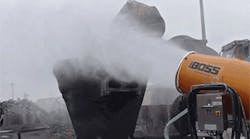Slag dust is a hazardous by-product for virtually every operation melting metal. Electric steelmaker Gerdau Ameristeel Cambridge, in Cambridge, ON, sought to address the problem and to improve safety and cleanliness, by preventing dust migration.
Producing 300,000 tons annually of low- to medium-carbon steel bars, primarily from a feedstock of recycled materials, left several tons of slag to be purged at the end of the casting sequence. “When ladles and tundishes are dumped, the falling slag has the potential to create large quantities of dust,” according to senior engineer John Andric.
Although the melt shop is enclosed, there is a draft from one end to the other, Andric explained, which made using a baghouse dust collector and overhead canopy a dicey prospect. “The project estimate was well over a million dollars, and there were doubts as to how successful it would be,” said Andric. “The concern was how effectively the canopy over the cranes would prevent (dust) migration. We needed something that could control the dust quickly as it was generated, at ground level.”
Dust Control Technology (DCT) develops dust and odor control systems for steel and slag, material recycling, and scrap processing, just to name a few. Its DustBoss product line can be operated by remote control from an overhead crane, from a front loader, or at ground level by control panel.
DCT CEO Edwin Peterson described three different opportunities for slag particles to emerge during processing, as at Gerdau Ameristeel Cambridge. “The first is from the initial fall of material, and is usually of short duration. The second occurs during subsequent tempering and cooling operations, when vapor from the cooling water rises and carries particulates into the air. Dust also can be released at any time a particle’s terminal settling velocity (from gravity) is lower than the thermal updraft velocity (from heat), which causes it to rise and potentially migrate.”
The DustBoss equipment has been tested at a number of slag processing sites, with various modifications and configurations evaluated in a range of combinations to gauge their effectiveness. Some have been affixed to trailers or flatbed trucks to deliver virtually unlimited mobility, while others have been permanently mounted on towers or in other elevated locations.
One of the factors to the equipment’s success is its ability to operate automatically, allowing slag processors to control on/off cycles, direction, oscillation arc, and other features from remote location or via hand-held wireless control. Fullyintegrated systems can be operated entirely by remote control whenever a slag dump is underway, so a single operator can selectively adjust as many as 100 of the high-output misting units without having to ‘visit’ any of them personally.
After witnessing a DCT unit in action at another steel melt shop, Gerdau Ameristeel Cambridge opted for a DB-30 for its slag dump area. It is the smallest of the DustBoss family, and known for capturing dust particles more effectively than many larger machines. Mounted on a movable carriage, the unit features a 7.5-HP motor that generates 9,200 CFM of air flow. The ducted fan design has an adjustable throw angle range from 0-50° elevation and the standard unit oscillates up to 70°. When equipped with the new 359° oscillation option, the DB-30 can cover more than 30,000 ft2 of area, nearly three quarters of an acre, using just a standard 5/8-in. garden hose.
Gerdau Ameristeel Cambridge mounted its DB-30 in an elevated location above the dump area and direct-wired it to a 575-volt, 3-phase service. The company uses the city water supply, delivered through a heat-traced and insulated line, so pressure remains at a constant 40-60 PSI.
“It does just what it was designed to do, delivering the mist over a wide coverage area,” says Andric. “The dust particles and water droplets are brought into collision with each other, which prevents the dust from drifting through the shop.”











